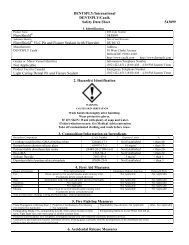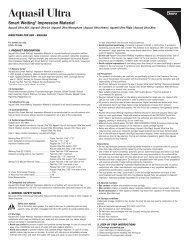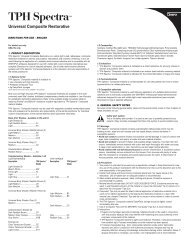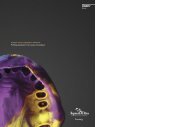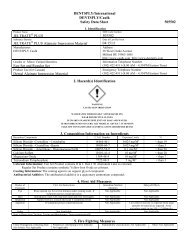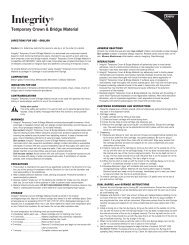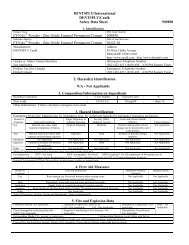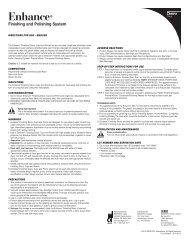Indirect and Direct Restorative Protocols - Caulk
Indirect and Direct Restorative Protocols - Caulk
Indirect and Direct Restorative Protocols - Caulk
Create successful ePaper yourself
Turn your PDF publications into a flip-book with our unique Google optimized e-Paper software.
››“The B4 Surface Optimizer helps me<br />
work faster by adapting each surface<br />
<strong>and</strong> readying the tissues for precise<br />
impression capture.”<br />
David Parker, DDS<br />
Private practice, Smithtown, NY.<br />
Figure 3. The cord is removed immediately prior to taking the impression,<br />
with caution exercised to avoid tearing the cord or damaging the<br />
soft tissues, which will cause sulcular bleeding <strong>and</strong> obscure marginal<br />
detail in the resulting impression.<br />
Figure 4. Use of the B4 ® Pre-impression Surface Optimizer (DENTSPLY<br />
<strong>Caulk</strong>, Milford, DE) coats the hard <strong>and</strong> soft tissue surfaces to allow<br />
the syringed wash material to pass more easily over <strong>and</strong> around the<br />
surfaces to be impressed.<br />
Table. Achieving Predictable Tissue Retraction: Treatment Rationale<br />
Method Rationale Considerations<br />
Cords<br />
n Enhanced degree of mechanical displacement<br />
n Available with or without a hemostatic agent<br />
n Available in a variety of types <strong>and</strong> thicknessesto<br />
accommodate a range of procedures<br />
n Care must be taken to avoid soft tissue trauma<br />
n Often requires the use of local anesthesia<br />
n The ability to absorb hemostatic agents must<br />
be taken into account during cord selection<br />
Pastes<br />
n Completely atraumatic to soft tissue<br />
n Local anesthesia is not required<br />
n Expeditious application may be advantageous<br />
in multi-abutment situations<br />
n Vigorous rinsing is required for removal<br />
n Does not work well in narrow or shallow sulci<br />
n Does not provide the same degree of displacement<br />
as the cord technique<br />
Insertion <strong>and</strong> removal of the retraction<br />
cord should be performed<br />
with great care to avoid inflicting<br />
trauma to the soft tissue <strong>and</strong> ensure<br />
optimal patient comfort (Figure 3).<br />
Use of a pre-impression surface optimizer<br />
(B4®, DENTSPLY <strong>Caulk</strong>,<br />
Milford, DE) will further ensure<br />
predictable marginal accuracy <strong>and</strong><br />
precise data capture by coating the<br />
hard <strong>and</strong> soft tissues <strong>and</strong> allowing<br />
the wash material to better flow over<br />
<strong>and</strong> around them for improved accuracy<br />
(Figure 4).<br />
The highly wettable Aquasil Ultra<br />
Smart Wetting® Impression Material<br />
(DENTSPLY <strong>Caulk</strong>, Milford, DE) is designed<br />
to aid the clinician in maintaining<br />
adequate moisture control during<br />
the process. When using this hydrophilic<br />
material, the preparation area should be<br />
moist, but pooled liquid should first be<br />
removed with an evacuator to avoid the<br />
creation of an excessively moist field.<br />
When conducted accordingly, an impression<br />
material can thus flow subgingivally<br />
<strong>and</strong> capture the details of the tooth<br />
<strong>and</strong> ensure proper integration with the<br />
periodontal tissues. In fixed prosthodontic<br />
care, where the smallest subtleties have<br />
a considerable impact on the outcome of<br />
treatment, proper tissue management<br />
<strong>and</strong> tissue retraction are critical. n<br />
10



